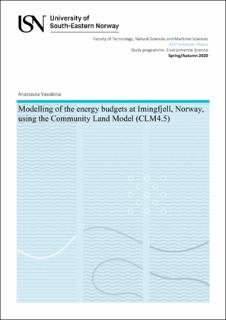| dc.description.abstract | Mountains are one of the most sensitive areas to climate change as they are biodiversity hotspots. One of the main problems in studying climate change for mountainous territories is the lack of meteorological data due to their inaccessibility. Currently, modelling is the most commonly used method for data scarcity, but it is still difficult to assess the effectiveness of models. Here, the Community Land Model 4.5 (CLM4.5) was used as a model for testing, with Mount Imingfjell in Southern Norway as the study object. The results of two experiments, the STANDARD and RCP4.5 experiments, were analysed to determine how the simulated results resemble the measured energy and radiation budgets at Imingfjell and to predict possible future changes in their components under the RCP4.5 scenario, respectively. In the STANDARD experiment, model inputs were compared with weather parameters from the two meteorological stations closest to Imingfjell for the period of 2002-2016, and model outputs were compared with measurements of the radiation and energy budgets for two types of vegetation (lichen and shrubs) from our research site at Imingfjell in summers 2018-2019. In the RCP4.5 experiment, the radiation and energy budgets components were compared between three different time periods from 1850 to 2100. Analysis of the input data in the STANDARD experiment indicated that CLM4.5 underestimated the Imingfjell altitude by 3 times and gave plausible results of all input parameters, but not for the actual height. As for the output data, the simulated data was in most cases closer to the data of shrubs than lichens. The RCP4.5 experiment showed that only half of the fluxes (QH, QE, K↑, L↓ and L*) have changed from pre-industrial times to the present day, but most of them, except QE, QG, and L*, will change by the end of 21st century. | en_US |
